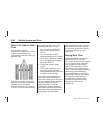
6. The driver side front indicator
lamp turns off and the
passenger side front indicator
lamp comes on to indicate
that corner’s sensor is ready to
be learned. Proceed to the
passenger side front tire and
repeat the procedure in Step 5.
7. The passenger side front
indicator lamp turns off and the
passenger side rear indicator
lamp comes on to indicate that
corner’s sensor is ready to
be learned. Proceed to the
passenger side rear tire and
repeat the procedure in Step 5.
8. The passenger side rear indicator
lamp turns off and the driver side
rear indicator lamp comes on to
indicate that corner’s sensor is
ready to be learned. Proceed to
the driver side rear tire, and
repeat the procedure in Step 5.
9. After the driver side rear TPMS
sensor has been learned the
horn chirps two times. The driver
side rear indicator lamp turns
off and the TPMS sensor
matching process is done. Turn
the ignition switch to LOCK/OFF.
If no tires are learned after
entering the TPMS learn mode,
or if communication with the
receiver stops, or if the time limit
has expired, turn the ignition
switch to LOCK/OFF and
start over beginning with Step 2.
10. Set all four tires to the
recommended air pressure level
as indicated on the Tire and
Loading Information label.
11. Put the valve caps back on the
valve stems.
Tire Inspection and
Rotation
We recommend that you
regularly inspect the vehicle’s
tires, including the spare tire, for
signs of wear or damage.
See When It Is Time for New
Tires on page 9-56 for more
information.
Tires should be rotated every
5,000 to 8,000 miles (8 000 to
13 000 km). See Scheduled
Maintenance on page 11-4.
The purpose of a regular tire
rotation is to achieve a uniform
wear for all tires on the vehicle.
This will ensure that your vehicle
continues to perform most like it
did when the tires were new.
9-54 Vehicle Service and Care
2008 - Pontiac G8 Owner Manual


















